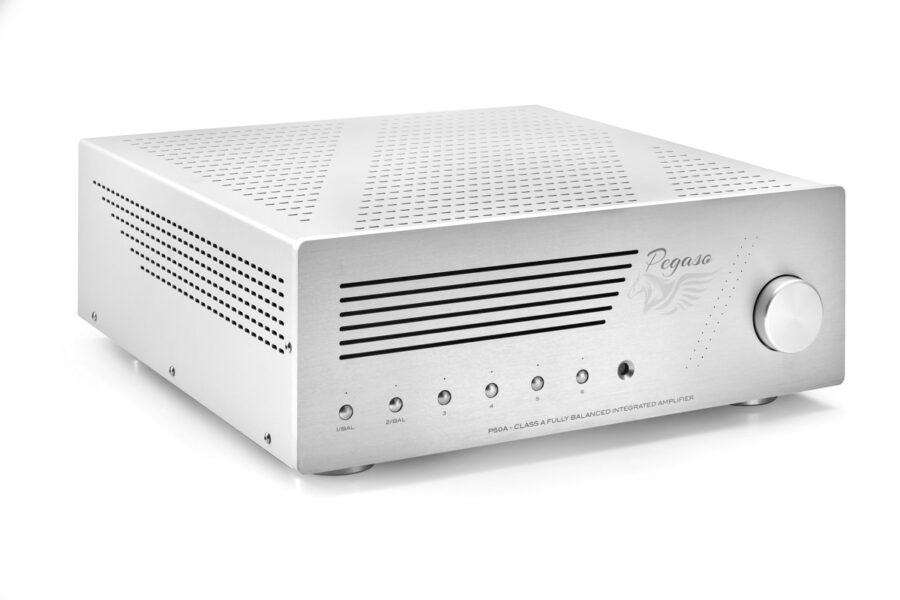Some people stick to a rule or a principle that they find plausible and a likely guarantee for a greater end result. And that’s find. Principled people are often thorough and generally know what they’re doing. On the other hand, there’s a temptation to think that it’s not the rule or principle as such that matters but what one does with it or them. Flexibility. Thinking without prejudices. And that applies to tube amplifiers as well. Single-ended or push-pull, feedback or no feedback, a coupling cap or without etc. etc. etc. This came to my mind naturally when I received Pegaso Audio’s PA50 amplifier for a review, the only amplifier model the Italian manufacturer offers currently.
Now, if the Pegaso P50A were a ‘standard’ integrated tube amplifier, as we commonly understand it, it would have a tube stage or two welcoming the input signal just after the input selector, providing a suitable input impedance and signal amplification for the source. There would then, possibly, be another tube stage amplifying the signal before the signal tubes of the output stage, and finally two pairs of output tubes.
But the Pegaso P50 doesn’t follow the standard procedure. Instead, input signals are first met by the input selector section, which in Pegaso’s case is a purely passive relay field (input selection) controlled by the push buttons on the front panel. The next section on the circuit board is a line buffer (input buffer), with one 8-foot surface-mounted analog IC amplifier on each side. No type marking, but judging from the fact that optional symmetrical inputs are probably also implemented on the microcircuits, it could well be a double operational amplifier.
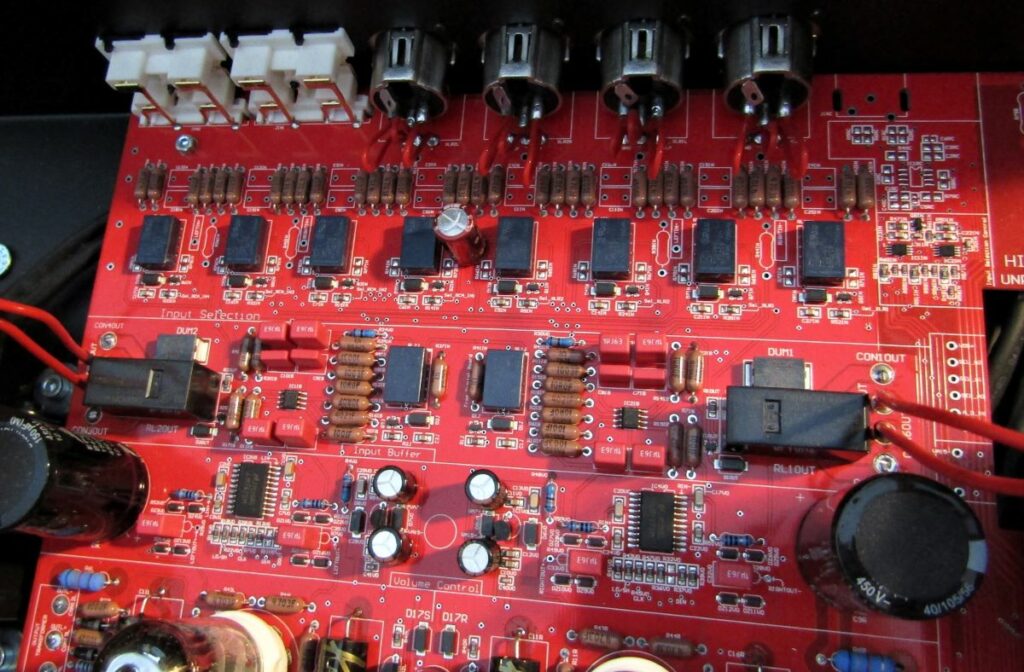
Apparently, the buffer also performs an electrical impedance equalization to the output of the active volume control circuit (recommended in the datasheet). No information is provided on whether the buffer also provides additional amplification, but keeping in mind the high sensitivity of the output stage (480 mV), it seems that it would present a traditional unity-gain buffer, i.e. the same voltage level at the input and output.
The buffer is followed by a volume control section, implemented with a purpose-designed digitally controlled active volume control circuit (Texas Instruments LM1972), on its own circuit for both channels. This may not be an orthodox solution, but apparently it has become a more and more acceptable solution also in high-end tube amplifiers replacing the traditional motor-controlled potentiometer. As said, Pegaso P50A does not shy away from microprocessors on “as long as it works” basis. In this regard, lessons have been learned from Audio Analogue’s amplifiers in which microcircuits are not overlooked. The circuit has a resistance network (“ladder”), from which suitable damping can be obtained by switching with semiconductors. The same control circuits are also used to adjust the channel balance. The separate microcontroller needed for the control is attached to the circuit board on the back of the front panel.
The output stage looks like a fairly normal push-pull stage with four 6922/ECC88 signal tubes and two pairs of KT90 beam-power pentodes. (Our tube amp specialist Mauri Pännäri kindly helped to clarify the topology.)
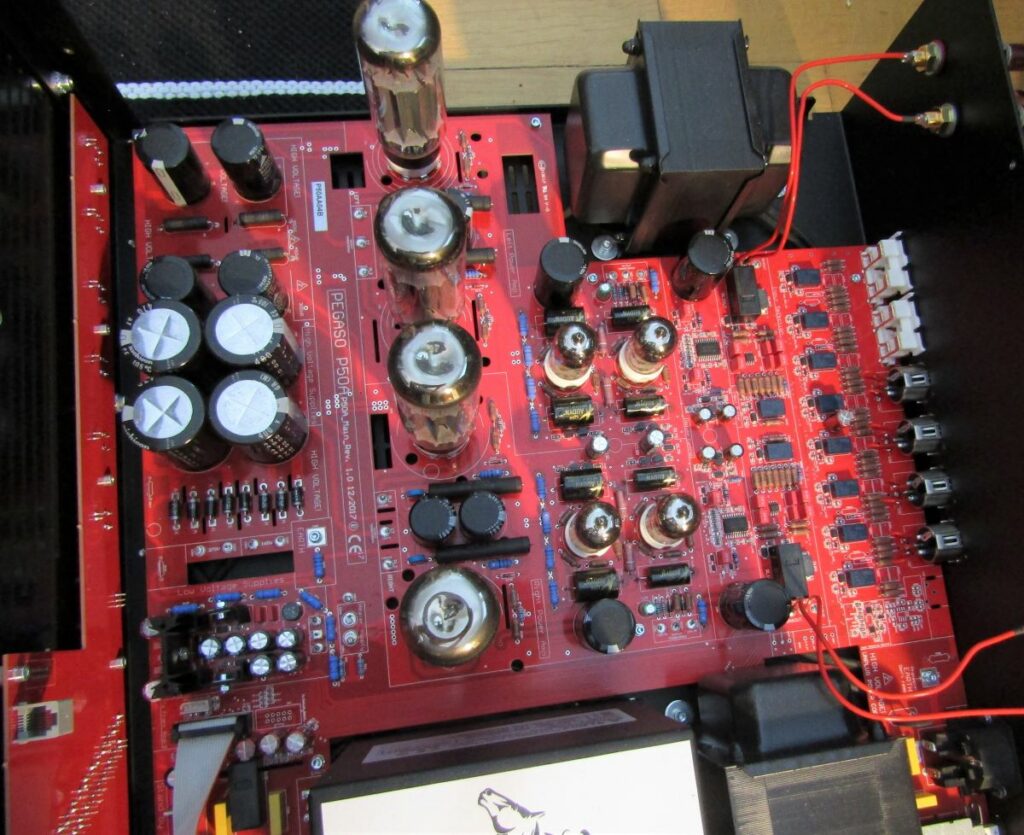
Amplifier’s identity
So what kind of amplifier the Pegaso is? A hybrid? The hybrid would nicely fit the picture in that the mother company of the Pegaso, another Italian company called Audio Analogue, is known for its transistor amplifiers (eg. the legendary Puccini from 1996), but also for launching a series of hybrid amplifiers over the years. In fact, the Primo Cento from 2004 looks much like the Pegaso P50A from outside, and is a hybrid; but unlike the Pegaso, the now defunct Primo Cento was a genuine hybrid with 6922 triodes at the front and Texas Instrument’s LM3886 microcircuit amplifiers responsible for the output stage (the same microcircuit was reportedly used by Jeff Rowland in their amplifiers).
In the Pegaso P50A, the roles, as we saw, have changed: there is an active line buffer/volume control stage in front, and tubes at the end. I guess we can call this design too as hybrid, but one can just as well think of it as a tube power amp with tubes at the output together with a fairly streamlined front end. However, the implementation is not as simple as in some VTL’s older models, which had only one adjustable line input added for only one source with pots on the front plate.
The Pegaso P50A offers a line input for six program sources; four asymmetrical (100kOhm, max. 3.5V rms) and two symmetrical (100kOhm, max. 7V rms). The amp also sports a few usable preamp controls, more of which below. If an amplifier has to belong to some category, perhaps the Pegaso P50A’s identity could be placed somewhere between a traditional hybrid amp and a sufficiently well-equipped tube power amplifier.
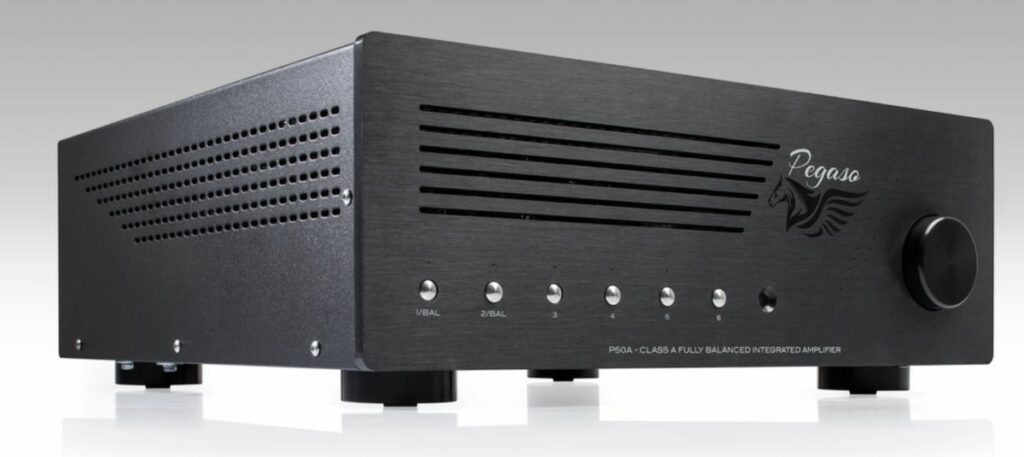
A massive amplifier
At first glance, the P50A is a massive 30 kg amplifier, whose dimensions (455 x 175 x 465 mm) challenge the limits of a standard rack. Inside, the scenery is dominated by one big red circuit board with almost all the functions down to the power supply. The anonymous output transformers are symmetrically placed on both sides of the output stage, but the mains transformer with a metal protective cover not centered. Audyn, Epcos and Nichicon capacitors stand out on the circuit board. According to the manufacturer, the caps /hooks ? and through-hole resistors have passed functional safety tests at high temperatures. The included thick power cord is not the usual standard power cord.
KT90 is an octal base power pentode, or more precisely a jet tetrode, designed for an audio amplifier use. It can be replaced with KT88, 6550 or EL34. The tube was developed by Elektronska Industrija Niš, or Ei, in the former Yugoslavia, and for a long period of time was only manufactured at the Electro-Harmonix factory in Russia. Data sheet says predicts that a push-pull pair of KT90s delivers an output power of 110 W (anode 50W/550V). The P50A is said to give only 50 watts at 8 ohms/1kHz with 0.3% total harmonic distortion, and at ten watts, THD + N 0.07%. Those distortion figures aren’t anything unusual for a tube amplifier. Judging from the output power, Class A function, and from 12dB negative feedback, it would seem that the KT90’s are pentode-coupled, but ultra-linear coupling is also within the limits. Whether all 50 watts are really Class A watts is open to a question. Class AB1 wouldn’t be a surprise either.
The front-end microcircuits are key to Pegaso’s noise performance. The manufacturer claims A-weighted signal/noise ratio of 95dB (0dB, 8 Ohm, 1Khz, 20Hz – 20kHz). Not exactly a record result, but in practice, which is more important, the amplifier was as quiet as can be reasonably (ie. not bat-like) required from an amplifier. I couldn’t detect noticeable noise even with my multi-cell horns.
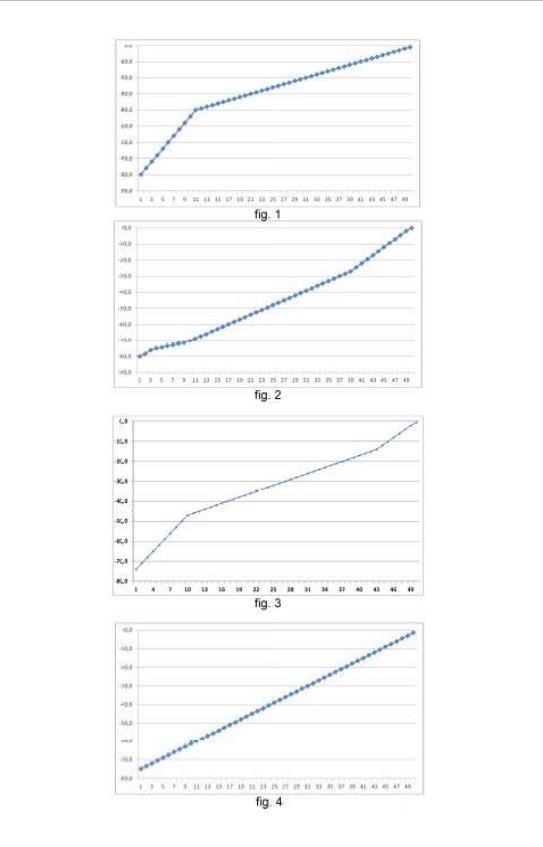
Flexible intensity control
The Pegaso gets started (not suprisengly) by switching the POWER button, and when the lights stop flashing, then pressing the STAND BY button, after which the device prepares the tubes for use for less than a minute. Even after this, it’s worth letting the amplifier (output transformers) to settle for 5 to 30 minutes before critical listening.
Input selection and volume adjustment are handled through the front panel buttons or from the steely remote. All other adjustments (LED dimming, channel balance, etc.) can only be made via the SET UP button on the remote control.
The selection of the the volume control’s angle profile turned out to be a particularly useful feature. When the sensitivity of the amplifier is about 0.5V, even a small turn of the volume may increase the volume too quickly, depending on the sensitivity of the speaker, for example. The P50A offers 4 different Volume scales for the problem. The mid-sensitive speakers have a factory-preset mode that offers a steeper rise at the beginning of the scale and a gentler in the middle and end. I’d say this meets most people’s listening needs and preferences. Mode 2 increases the volume more gently at the beginning, but then steepens faster at the upper end of the adjustment, which is suitable for sensitive speakers. I found these two useful, but there were also situations where a more subtle adjustment option – mode 3 – in the middle of the adjustment scale served listening best. Mode 4 equals a fully linear dB scale over the entire adjustment range.
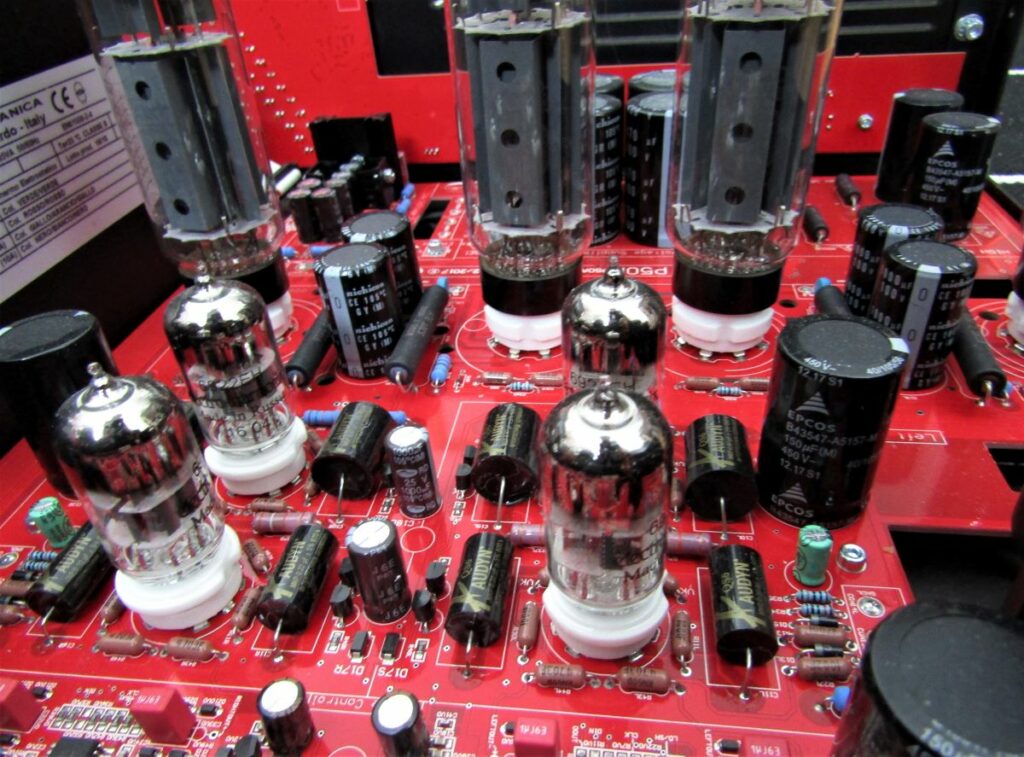
Power and impedance
Did Pegaso offer enough power? With my sensitive speakers, and for my own purposes and listening preferences: Yes, definitely. It was equally clear that the Pegaso P50A ain’t a 250 watter, which may matter in some situations. As is well known, tube amplifiers with a 8 ohm transformer output do not double their power to a 4 ohm load (and do not halve to 16 ohm). Owners of four-ohm speakers should therefore not expect more than 50W Pegaso output, rather somewhat lower.
For low-ohm speakers, Pegaso’s 2.6 ohm output impedance may pose a more considerable issue than the power. The figure is not completely unusual for a tube amplifier, but still kind of high for a modern realization. When the high input impedance becomes a significant part of the load impedance, frequency response changes due to the impedance varying with the frequency may occur, especially at lower frequencies. With my > 6 ohm speakers, the bass reproduction was by no means particularly soft or lackluster. The double bass sounded like itself, and there was enough kick and effort for general need. However, I’d recommend that owners of low-impedance speakers do their experiments first. Those enthusiasts who prioritize the tightest bass, probably do better with a transistor power amp.
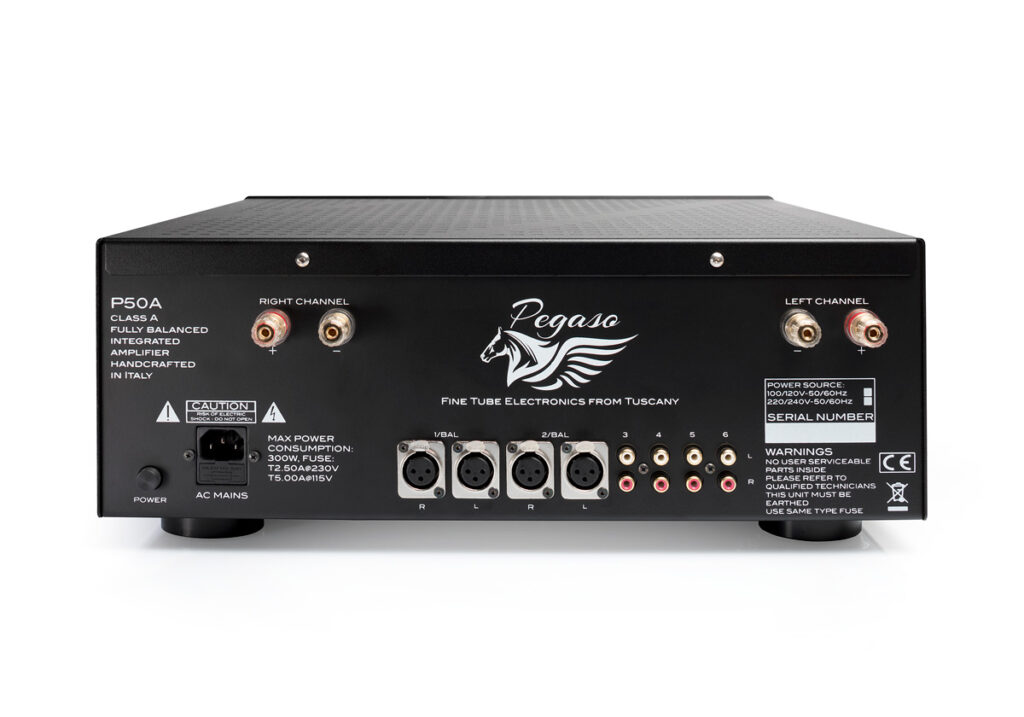
Hard and soft politics
The output impedance could have been reduced by increasing the amount of negative feedback, but the manufacturer has chosen not to do that, most obviously for reasons of tonal policy. A rich, ear-friendly tonality is the domain of tube amplifiers, and my first reaction to the Pegaso P50A’s sound color and the method it reproduced the sound was a feeling of relief. The relaxation of listening emanates in part from the fact that the sound seems to be lacking what is often described as the opposite of softness.
Studies have found that most women and non-professionals with healthy ears systematically choose, out of two sounds, the sound that they interpret as sounding softer. For the same reason, many hobbyists enjoy the sound of old tube radios, even when they know it’s not Hi-Fi. The crystal clear sound (from an amplifier, crossover, tweeter etc.), common in Hi-Fi circles, is foreign to the world of live and natural sound. Concertgoers may complain about the loudness of the sound, but rarely about the excessive brightness or hardness of the sound of the concert hall.
However, there are different kinds of softness, and not all is equally good. If a loose analogy or generalization is allowed, if one does hard and strict politics with hard and strict methods, the end result sounds like a high feedback transistor amplifier. Doing soft politics with soft methods means can produce a pleasant sound, but also one that us woolly and tiring, which was the case with some elder tube amps. But when one exercises hard and strict politics, but use soft means, it creates a sound that can only be found in the best tube amplifiers. Pegaso writes that it appreciates a sound that is wonderful, precise and dynamic in nature, but also nuanced, light and pleasant to listen to.
Experiments with preamps
I personally found the tone of the P50A to be rather universal in nature, and as a whole, such that is closer to a conventional push-pull pentode amplifier than, for example, the Audio Note Cobra, that specializes in midrange naturalness. But what about PA50’s resolution and transparency? I decided to investigate this by bypassing the Pegaso’s buffer and volume adjustment, and replace it, first, with an passive preamp (ELMA’s step attenuator), and, second, with a vintage 12AX7/E88CC preamp. The Pegaso’s entire front can easily be routed over by configuring one of the amp’s inputs as a power amp input. The 100 kilo-ohms input impedance guarantees that changes in the frequency response, even with a passive pre, remain improbable.
Purely subjectively, through the passive pre, the sound was an obvious disappointment. The tone was grayer, all kinds of zest and liveliness were missing, the whole felt more indifferent. In addition, the whole show was surprisingly uninspiring. The fact was that the front end microcircuits on the signal path, the amplifier simply sounded more like a tube amplifier! The situation was more even with a tube preamp. Maybe through the preamp the sound was a bit more powerful, the tone a step lighter but overall no big difference. It was clear that tonally speaking the Pegaso’s output stage benefits from an active front end, whether realized with tubes or transistors or integrated circuits.
The major difference between tubes and microprocessors was in spatial reproduction. The tube preamp blew more air into the sound, made the sound bigger and more holographic, and thereby increased the vitality of the sound. On the other hand, the Pegaso’s more restricted sound image gave the impression of being more accurate, the sound remaining dead on between the speakers. All in all, the preamp test spoke in favour of the fact that, as regards PA50, Pegaso must have made right choices with the relays, buffer, signal balancing and volume control. Again, this is not surprising given that the parent company Audio Analogue has a long experience with, for example, the use of microcircuits in its amplifiers.
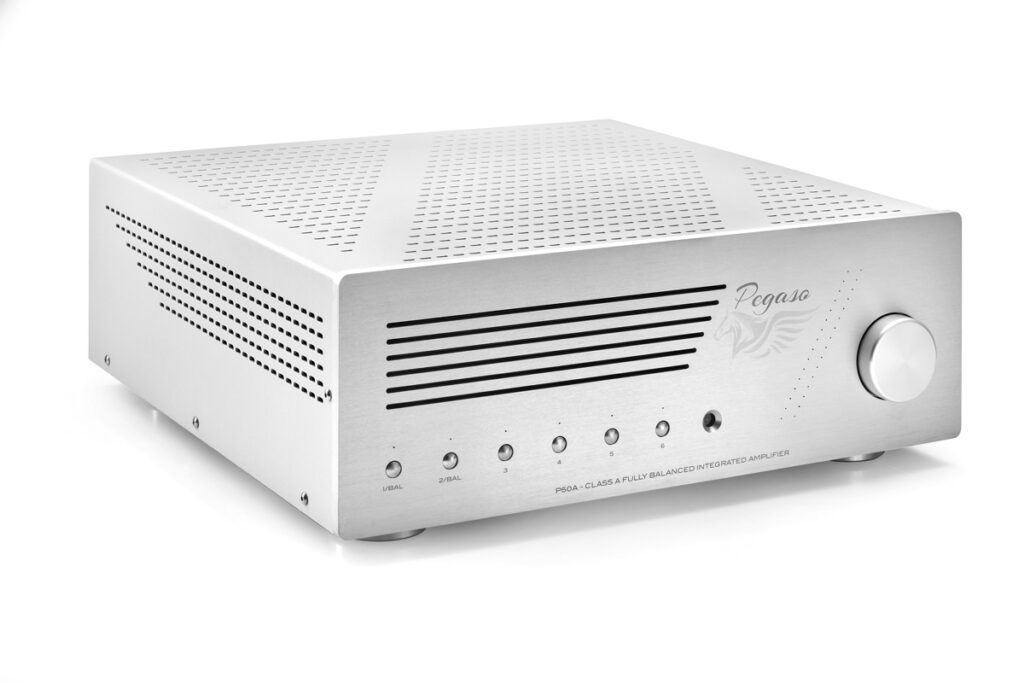
Purely analog
When AF Group SRL decided to launch the Pegaso brand in 2017, the idea was that the aforementioned experience and know-how gained from Audio Analogue’s transistor amplifiers could be utilized in designing a reference-level tube amplifier. Probably so. The ethos may have been taken from, for example, the massive Class A amplifier launched by Audio Analogue in 2006, which is still one of the manufacturer’s finest achievements.
The Pegaso P50A is an interesting case among audio amplifiers in that it does not shy away from belonging to the past world, when the RIAA input disappeared from integrated amplifiers, and the DACs had not yet managed to nest in them. It’s a pretty bold bet to offer an amplifier in the 2020s that can be used only together with a CD player or tuner or tape recorder (playback)! The message sent to friends of LPs, streamers and headphones, who make up a pretty big customer base today, is to save a little money to get a suitable pre-amplifier. However, the Pegaso P50A is not alone. Similar purely analog amplifiers can be found, for example, chez Musical Fifelity: Nu-Vista 600 and Marantz: PM-10. All three represent the same top class of amplifiers in terms of dimensions and weight, and of all of them it can be said that, at least on the visual level, the greatest efforts have been put into the operation of the amplifier as an amplifier.
Compared to these two competitors, the Pegaso P50A is more boxy and stripped down on the outside. However, the rugged beauty reminds us that the most important thing is found inside the case, and that with the right layout and component choices, one can build a great-sounding Hi-Fi amplifier, whether it’s tubes, transistors or microcircuits – the legacy of the tube amplifier guru Tim de Paravicini.
The price of Pegaso PA50 has hovered around 5000 euros.


